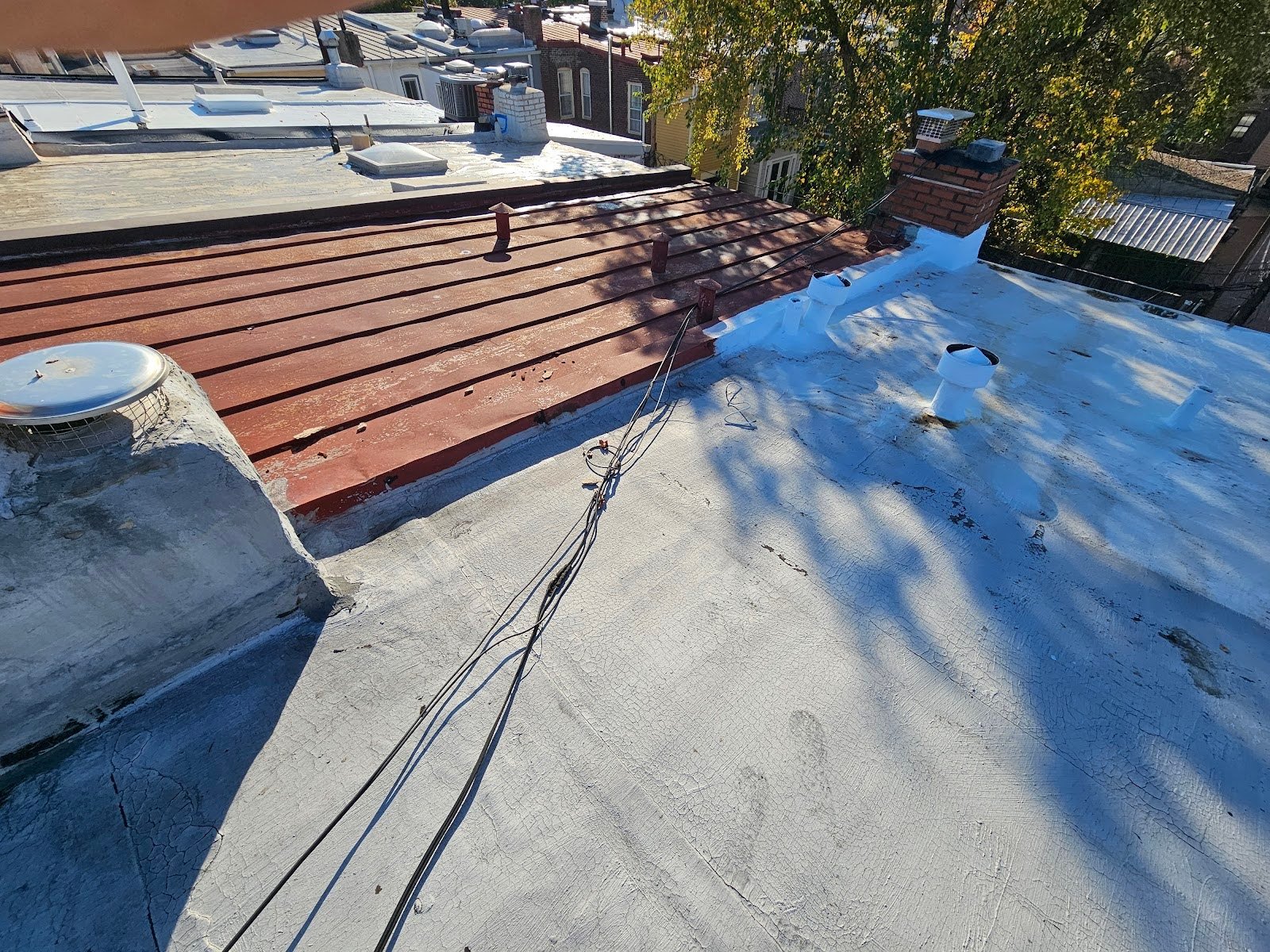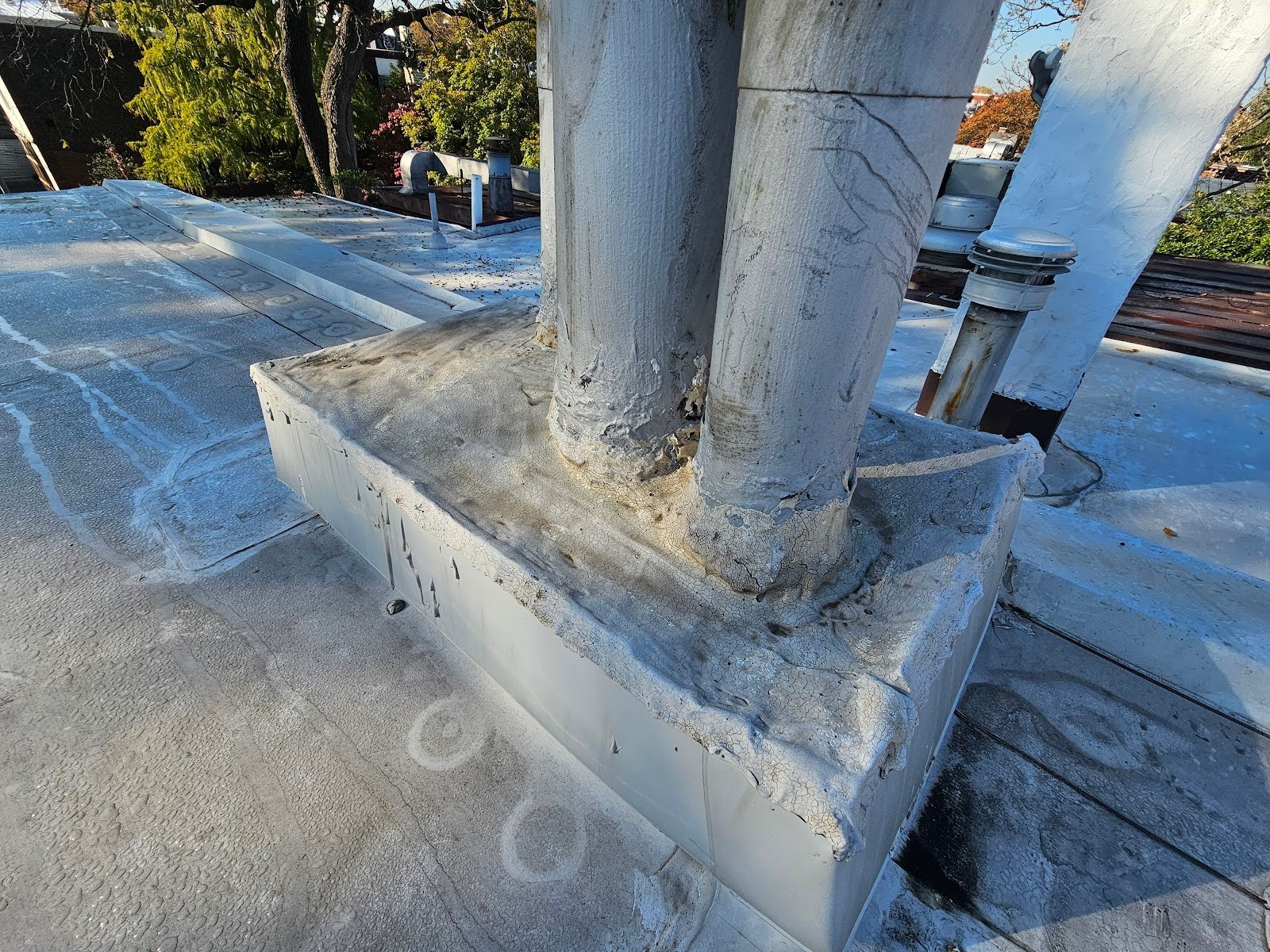Protect flat roofs with Modified Bitumen Roof Coatings
The picture below shows an example of a white painted modified bitumen roof. The roofing material that the roof is actually made from comes from the manufacturer or factory in an almost black type color. Modified bitumen membranes are available in a few different classes of characteristics. One class of modified bitumen roof membrane has a ceramic granule set into the top surface of the roll membrane roofing.
Another alternative class is a smooth membrane with no granules. The smooth membrane is more common and it needs to be coated, it’s not supposed to be installed just as is without any coating applied on top. The coating is intended to be reapplied every few years. This is a burdensome extra bit of maintenance, but it’s part of how this type of system is intended to work.
The picture below shows an example of a white painted modified bitumen row home roof. Like many row homes here in Washington DC, the layout is relatively consistent from one to the next. From one roof to the next though there are differences in the quantity of penetrations of piping through the roof, number of skylights, quantity and location of chimneys, for example. And some roofs might be significantly larger or smaller than others. However, with all these different potential varieties or variations in characteristics and configuration, the overall configuration of a larger front section of the roof with a smaller or thinner rear section accompanied by an adjacent rear ell is very common.

The next picture below shows a very similar but different roof. This is also a modified bitumen smooth roof system. However, this roof was never painted, and even to this day, years after the initial installation remains unpainted. Roofs of this type are not intended to be left unpainted. The alternative similar type of modified bitumen, with a ceramic granular applied on top of the roll roof membrane has this applied element, of the granules, to stop the deterioration from ultraviolet exposure. Here though, as shown in the picture below, with the smooth modified bitumen membrane, there are no granules applied and the modified bitumen membrane is left completely defenseless, exposed to the deleterious effects of sunlight.

If you look closely throughout the surface of the roof membrane, there are many locations and overall general indications of deterioration that could be avoided through proper coating of the roof system. Applying a coating to the roof system isn’t done for the purpose of preventing leakage specifically, instead it is intended and generally effective at limiting or deterring deterioration from exposure to ultraviolet rays in sunlight. In general, we recommend a proper coating be applied within roughly 3 to 6 months after initial installation. Generally, the membrane should be given some time to weather after initial installation. That helps with allowing the membrane to acclimate to the exterior conditions before the coating is applied.
The picture below shows an area of deterioration in the bleed-out of the emulsion at the underside of the membrane. This type of membrane is often also referred to as torch-down roofing. The underside of the roofing is heated with an open flame, from a roofing torch.

A close view follows below in the next picture as well. This type of damage is relatively common when roofs are not coated to protect them from the damage of ultraviolet rays. This type of damage leads to alligatoring which in effect is a splitting of the surface of the bitumen elements. The bitumen elements in the single-ply membrane are held together with multiple types of reinforcement fibers.
These reinforcement fibers eventually will also become damaged from exposure to ultraviolet, but particularly in this case, when there is alligatoring or cracking at the surface of the membrane, it is the first type of deterioration which expands and continues. This type of deterioration generally happens at an increasing rate. For example, as these areas at the upper surface begin to split apart, they expose the underlying areas of the membrane which then are also affected by the same ultraviolet rays which they were previously protected from by the materials above.

Even though modified bitumen membranes like this are called single-ply membranes, they have multiple layers, even within one single-ply membrane. In the next picture below you can see an example of where the upper layer has deteriorated and worn off from the single-ply membrane.

In this coming week’s blog, we will continue talking about modified bitumen membranes and coatings applied to the particular type of smooth modified bitumen membrane systems. These roof systems are extremely common here in Washington DC and particularly at many different types of low slope or flat roof buildings.
We provide this information here on our blog, and our website, to help our customers and future clients, and we recommend every building owner in DC who values the longevity of their roof (and their investments) and building use a contractor who values the simple and important principles of proper roof construction like Dupont Roofing DC. Our company specializes in flat roofing here in Washington DC and we’re happy to help building owners of almost all types.
Learn more about our company and the proper techniques of working with roofing on historic buildings in Washington DC here on our blog at DupontRoofingDC.com, and you can call us at (202) 840-8698 and email us at dupontroofingdc@gmail.com. We are happy to help and at least talk through options.




